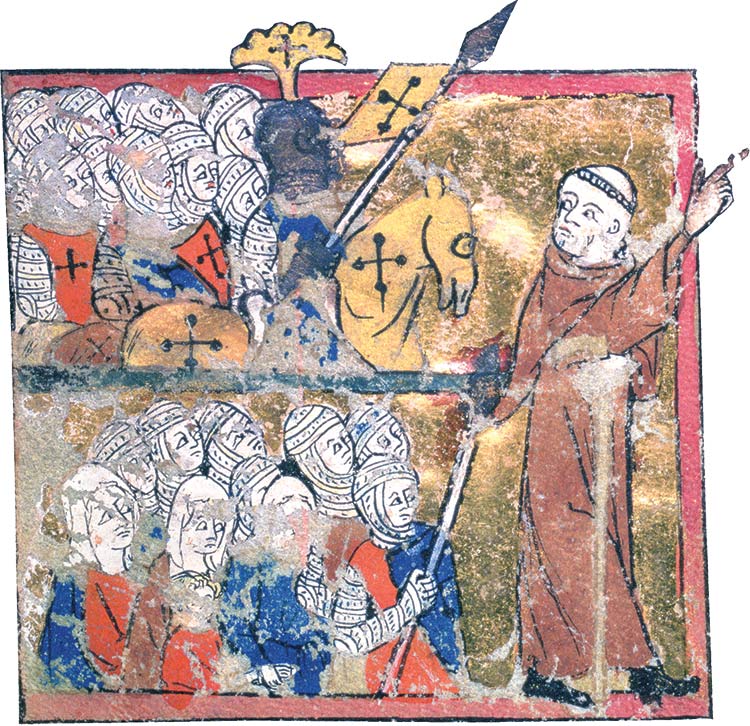Peter the Hermit dies in Flanders
A key figure in the First Crusade died on July 8th, 1115.
 The People's Crusade was one of history's weirder episodes. The city of Jerusalem, revered by Jews, Christians and Muslims alike, had been under Muslim rule for more than 400 years and Christian pilgrims from Europe had generally been treated tolerantly. Then in 1095 the Byzantine Emperor, Alexios Komnenos, asked Pope Urban II for aid against the Seljuq Turks, who were overrunning his territory in Asia Minor. The pope took the opportunity of a church council at Clermont in France in November to preach to the assembled delegates, bidding Christians to answer the call. What exactly the pope's motives were is uncertain and disputed because the contemporary versions of his oration differ considerably, but it seems he may have called for 'an armed pilgrimage' and conferred remission of sins on all who heeded him, which meant he promised them a life in heaven after death.
The People's Crusade was one of history's weirder episodes. The city of Jerusalem, revered by Jews, Christians and Muslims alike, had been under Muslim rule for more than 400 years and Christian pilgrims from Europe had generally been treated tolerantly. Then in 1095 the Byzantine Emperor, Alexios Komnenos, asked Pope Urban II for aid against the Seljuq Turks, who were overrunning his territory in Asia Minor. The pope took the opportunity of a church council at Clermont in France in November to preach to the assembled delegates, bidding Christians to answer the call. What exactly the pope's motives were is uncertain and disputed because the contemporary versions of his oration differ considerably, but it seems he may have called for 'an armed pilgrimage' and conferred remission of sins on all who heeded him, which meant he promised them a life in heaven after death.
If the pope had wanted an armed pilgrimage, that was not what he got at first. His call was passed on from European pulpits, but a priest from Amiens nicknamed Peter the Hermit also took up the cause. He was described by the chronicler Guibert of Nogent, who knew and admired him, as an ugly, swarthy, kindly little man, a devout ascetic who lived simply and went about barefoot. Now in his mid-forties perhaps, he was evidently a compelling personality and a mesmerising speaker and he travelled through northern France and into Germany, riding a donkey and gathering recruits to the cause.
By April 1096 Peter had assembled some 40,000 followers in Cologne. There were a few knights and trained warriors among them, but the majority were poor people, unarmed and with no military experience. Whole families often joined up, so there were women and children as well as men. Peter led them across Hungary and the Balkans and, although some of them gave up and went home and while the undisciplined behaviour of some pillaging for food alarmed the authorities along the way, Peter and the majority reached Constantinople safely late in July.
Peter's ragtag horde was not what the Emperor Alexios had expected or wanted. He treated Peter politely, but shipped him and his followers across the Bosphorus and into Anatolia as fast as he could. There the equally astonished Seljuq Turks, after cautious reconnaissance, gleefully attacked them. Thousands were slaughtered and those who were captured alive were sold into slavery. Peter and a few others had meanwhile gone back to Constantinople.
Between November 1096 and April 1097 successive detachments of experienced lords, knights and their fighting men, properly trained, armed and equipped, arrived in Constantinople under French and Norman leadership. In April 1097 they crossed into Anatolia and headed on south to Antioch.
Peter and a few followers went with them. He was someone who seemed to be in direct touch with the divine and his sermons helped to keep up the crusaders' morale. It was he who pronounced that an old spear they discovered at Antioch was the Holy Lance which had pierced Christ's side on the cross and, when the crusaders were trapped in the city and besieged in their turn, they sent him to negotiate with the Muslim war leader, Kerbogha of Mosul, and suggest a duel between him and a Christian leader to decide matters. Kerbogha declined and Peter now inspired the crusaders to sally out and drive the Muslims away. When the crusading army came to Jerusalem and set siege to the city in June 1099, Peter led proces- sions around the walls to summon divine aid and, after they had stormed it and were again trapped inside by a Muslim army, he led a procession from the Church of the Holy Sepulchre to the Temple and again inspired the crusading warriors to force their way out and drive the Muslims away.
That was in August 1099. Jerusalem was now securely under Christian rule and would soon be the capital of a Christian kingdom. Peter was back in Europe by 1100.
He founded an Augustinian monastery in Flanders and it was there that he died and was buried. Some writers in the 12th century hailed him rather than Pope Urban II as the true originator of the Crusade. They said that he had been to Jerusalem earlier and that Jesus had appeared to him in the Church of the Holy Sepulchre and commanded him to go back to Europe and tell everyone about the sufferings of their fellow Christians in the Holy City. Peter returned to Europe and went to Pope Urban to tell him what Jesus had said. It was that which inspired the pope to preach the Crusade. The story may perhaps have come from Peter himself. If so, it was a suitable myth with which to complete his curious career.